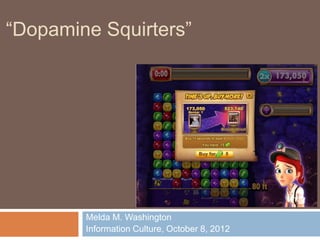
IDIA 620: Information Culture - Dopamine
- 1. “Dopamine Squirters” Melda M. Washington Information Culture, October 8, 2012
- 2. Overview Introduction – Why Dopamine? Definition Salience Games “Dopamine Squirters” Mashup Games Conclusion
- 3. Introduction – Why Dopamine? Conversation with fellow student Behavior: Anxiety Depression Relaxation Dopamine
- 4. Definition Primary neurotransmitter (chemicals in the brain that help communicate messages from cell to cell) found in the brain that is responsible for happiness and other emotions. It is essential for the normal functioning of the central nervous system. Provides feelings of enjoyment and reinforcement that motivate a person proactively to “feel good.” Sometimes referred to as the: “reward chemical” “pleasure molecule” “anti-stress” molecule
- 5. Salience Wikipedia states that Dopamine may also have a role in the salience or „noticeableness‟ of important stimuli, such as sources of: Reward Danger This hypothesis argues that dopamine assists decision-making by influencing the priority, or level of desire, of such stimuli to the person concerned. It has been argued that dopamine is more associated with anticipatory desire and motivation (commonly referred to as "wanting") as opposed to actual consummatory pleasure (commonly referred to as "liking").
- 6. Games A study in 1998 monitored changes in dopamine levels from subjects who were playing a video game. Noted that dopamine levels increased during game play “at least twofold” or doubled Games that are challenging or competitive increases dopamine level. Stimulation provokes excitement, in its absence, people feel bored. Patterns of intermittent reinforcement over time can release dopamine squirts. This “intermittent reinforcement” is the addictive quality of games and it affects people at the core level.
- 7. “Dopamine Squirters” Many popular games are “dopamine squirters” by: Deliverdopamine in small, frequent doses Give periodic, positive reinforcement Have achievements and leaderboards “Nags” (come play me alerts) Measurable, identifiable, frequent progress Give users a reason to come back to your game Players will play anything if they can advance, compete, or compare.
- 8. Mashup Games – programmableweb Programmablewe b lists 173 mashups tagged games. Most poplar are FlickerSudoku and Wii Earth. APIs used include: Flicker MicrosoftBingMap sGoogleMaps
- 9. Mashup Games - localiz.me An online treasure hunt game on Google Maps. APIs used include: GoogleStreetVie wImage, GoogleMaps.
- 10. Mashup Games - musicpopquiz.com Guess the artist from a song clip or a picture. Questions are randomly generated from the 7digital* catalogue and get more difficult as you progress through levels. Compare scores with others. APIs used include: 7digital. *7digital is a digital media delivery company.
- 11. Mashup Games - Climatecraft A Minecraft mod that adds tracking of carbon emissions using the AMEE API. APIs used include: AMEE. http://www.youtube. com/watch?v=L0DfI 98DuDM
- 12. Conclusion Mining the dopamine center for all it's worth If you are aware: of the patterns of intermittent reinforcement that over time, this can release dopamine squirts when people use your game anyone can be conditioned with the help of this pattern. YOU can design a game that fits into this pattern and take advantage of it. Marketers are testing that this dopamine-rush moment is the perfect time to reach out with a brand message.
- 13. References http://blogs- images.forbes.com/insertcoin/files/2012/03/gaming- graphic.jpg http://www.nytimes.com/2010/06/07/technology/07brain.html? pagewanted=all&_r=0 http://gamertherapist.com/blog/2011/11/08/dopey-about- dopamine-video-games-drugs-addiction/ http://en.wikipedia.org/wiki/Dopamine http://www.nrc- iol.org/cores/mialab/fijc/files/2002/120402_koepp_nature_199 8.pdf http://www.kotancode.com/2010/12/30/dopamine-squirts- intermittent-reinforcement-and-mobile-apps/
